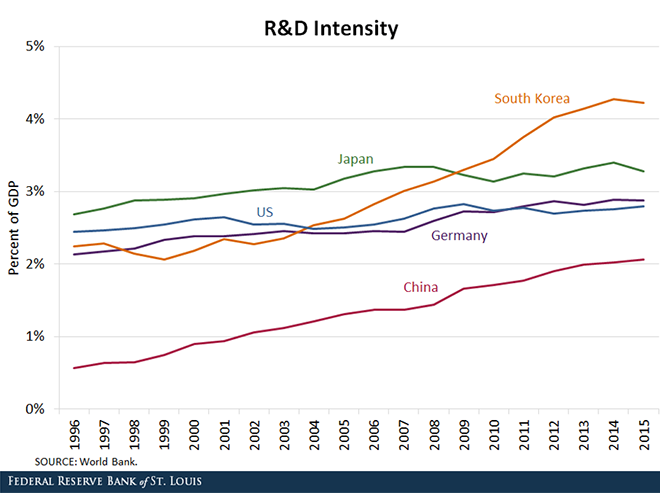How Did South Korea’s Economy Develop So Quickly?
South Korea has experienced one of the largest economic transformations of the past 60 years. It started as an agriculture-based economy in the 1960s,1 and it became the 11th largest economy in the world in terms of gross domestic product (GDP) in 2016.2 How did the industrialization miracle take place?
Factors in South Korea’s Economic Success
Many studies attribute South Korea’s structural transformation to policy reforms aimed at opening the country to foreign markets. Indeed, the export-oriented policies of South Korea are one of the most important factors of its success: South Korea is now one of the top 10 exporters in the world, and its exports as a percentage of GDP increased from 25.9 percent in 1995 to 56.3 percent in 2012.3
Two additional factors have contributed to the increase in international trade and industrialization in South Korea:
- An improvement in the business environment
- Policies incentivizing investment in innovation
Environment and Innovation
First, a strong business environment fosters growth in the domestic market and attracts foreign investors. According to the World Bank, South Korea is ranked No. 4 in terms of the overall Ease of Doing Business (DB) index in 2018, while the U.S. is ranked No. 6, as seen in the table below.4
| South Korea | United States | Japan | China | |
|---|---|---|---|---|
| Ease of Doing Business Rank | 4 | 6 | 34 | 78 |
| Starting a Business | 9 | 49 | 106 | 93 | Getting Electricity | 2 | 49 | 17 | 98 | Getting Credit | 55 | 2 | 77 | 68 | Trading across Borders | 33 | 36 | 51 | 97 | Enforcing Contracts | 1 | 16 | 51 | 5 | Resolving Insolvency | 5 | 3 | 1 | 56 |
| SOURCE: World Bank | ||||
Among the list of criteria, South Korea dominates in the ease to start a business and enforcing contracts. All of them play a significant role in encouraging investment, production, communication and, eventually, economic growth.
Second, South Korea has devoted extra attention to technology development and innovation to promote growth. Innovation and technology are the key factors that have underpinned South Korean export competitiveness and fueled the country's remarkable economic rise over the past decades.5
In fact, South Korea is now spending the largest share of its GDP on research and development (R&D), even larger than the U.S. and Japan, two of the global leaders in innovation based on R&D intensity. Between 1996 and 2015, South Korea’s R&D intensity grew 88.5 percent (from 2.24 percent in 1996 to 4.23 percent in 2015), while the U.S.’s only grew 14.4 percent (from 2.44 percent in 1996 to 2.79 percent in 2015).

Challenges for South Korea
Even though South Korea has been successful at promoting exports, its business environment and innovation, challenges still remain, including many from China.
Chinese competition is one challenge. Policymakers in China have also been emphasizing the importance of high-skill manufacturing and exports. This could have a negative impact on South Korea as China has traditionally been a large importer of South Korean goods. China is also catching up fast in innovation. Its R&D intensity has been approaching the levels of the U.S. and Japan.6
Furthermore, given South Korea’s relatively limited geographical size, natural resources and population size, an aging population aggravates the threat that South Korea’s economy might fall behind its fellow developed countries.7
To maintain sustainable economic growth, South Korea needs to continue its support in innovation and a favorable business environment.
Notes and References:
1 Kim, Kwan S. “The Korean Miracle (1962-1980) Revisited: Myths and Realities in Strategy and Development (PDF).” Kellogg Institute Working Paper #166, November 1991.
2 World Bank GDP ranking (PDF).
3 Iwulska, Aleksandra. Golden Growth: Restoring the lustre of the European economic model: Country Benchmarks (PDF), World Bank, 2012.
4 “Doing Business 2018: Reforming to Create Jobs (PDF).” World Bank Group, 2018.
5 Domínguez, Gabriel; and Mazumdaru, Srinivas. “Why innovation is king in South Korea.” Deutsche Welle, Feb. 10, 2016.
6 Santacreu, Ana Maria; and Zhu, Heting. “Has China Overtaken the U.S. in Terms of Innovation?” St. Louis Fed On the Economy, March 12, 2018.
7 Domínguez and Mazumdaru.
Additional Resources
- On the Economy: Has China Overtaken the U.S. in Terms of Innovation?
- On the Economy: When Does Trade Adjust after Being Liberalized?
- On the Economy: How Can Venezuela Address Its Hyperinflation?
This blog offers commentary, analysis and data from our economists and experts. Views expressed are not necessarily those of the St. Louis Fed or Federal Reserve System.
Email Us
All other blog-related questions




